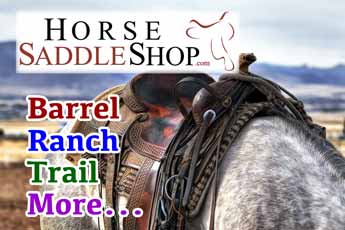What Is The History Of The Modern Bronc Riding Saddle?
The style of saddle currently used today in rodeo's saddle bronc riding event was first developed by Earl W. Bascom in 1922.
Below: A modern bronc riding saddle made on Earl Bascom's 1922 design.
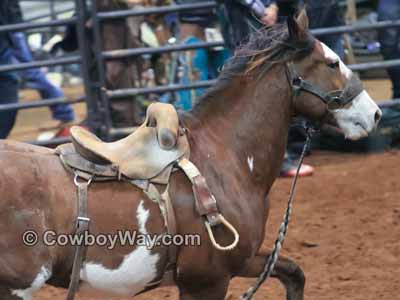
Introduction
The saddles used in today's saddle bronc riding event weren't always the same design in use today.
Before the current design, bronc riding saddles were typically the bronc rider's every-day ranch saddle, or at least one built in a similar design. But then Earl W. Bascom completely re-designed a new style of saddle from the ground up, one made specifically with bronc riding in mind instead of ranch work.
The major changes Mr. Bascom made to create an entirely new type of saddle are detailed in the article below.
Earl Bascom later became known as the "Father Of Modern Rodeo" thanks to his numerous inventions and designs used in the sport. These include:
- The side-delivery bucking chute in 1916.
- The reverse-opening, side-delivery bucking chute in 1919.
- The first hornless bucking saddle in 1922.
- The one-hand bareback rigging in 1924.
- He was also the first professional rodeo cowboy to become a professional cowboy artist and sculptor.
The following article on the history of the modern bronc riding saddle used in rodeo's saddle bronc event was written by Earl W. Bascom's son, John Bascom. We thank him for allowing us to share it with you here.
The History Of The Modern Hornless Bronc Saddle
By guest author John Bascom.
One-hundred years ago, rodeo's hornless bronc saddle was the creation of rodeo cowboy Earl W. Bascom.
Bascom's saddle design is now the standard bronc saddle used at rodeos and by rodeo associations across the United States and Canada as well as in New Zealand, Australia, Tasmania, South Africa and Europe.
Earl Bascom was born in 1906 in Vernal, Utah, the son of rancher and frontier lawman John W. Bascom.
John Bascom moved his family to southern Alberta, Canada in 1914 where he worked as a ranch foreman for one of the Cattle Barons of Canada, Raymond Knight.
By 1916, the Bascom family was ranching for themselves on Pot Hole Creek in Welling Station, Alberta.
John W. Bascom along with his sons Raymond, Melvin, Earl and Weldon - sometimes called the Bronc Bustin' Bascom Boys - broke horses for neighboring ranches, held ranch rodeos and furnished riding stock to other local rodeos.
You might like these items. Or, Article continues below.
New Rules, Old Saddles
When Earl started riding rodeo broncs, he wore the latest cowboy getup – fur chaps, leather cuffs, holding a braided quirt and riding an A-fork saddle.
Rodeo rules were simple - ride your stirrups, rock with the horse, spurring was not required, just stay on until the horse quit bucking, and don't buck off.
That style of riding worked well when riding an A-Fork saddle, but the rules of rodeo bronc riding started changing.
The new rule changes made it harder for the cowboy to ride and brought on a new style of riding.
Bucking horses were then being flanked, which caused the horse to kick high behind, rather than just rearing up.
The new rules required spurring in the shoulders - three times in the shoulders and then spurring high behind to the cantle board.
Since it was hard to spur riding a slick fork or A-fork saddle, cowboys started putting bucking rolls on their saddles.
Or they used saddles with swell-forks.
Quirting or fanning a bucking horse was outlawed, as well as using split leather reins.
Leather strap reins or braided sisal reins were permitted, but riding cross-reined was outlawed.
During this time, Earl Bascom had made an A-fork bronc saddle with bucking rolls and a deep-dished seat, one that brought him some notoriety as the cowboy Walt Whitney had won the saddle bronc championship riding it at a local rodeo.
But with the new rules for bronc riding coming into play, swell-fork saddles were much preferred over A-forks.
Re-Thinking Saddle Design
Earl decided to design and make a swell fork bronc saddle of his own.
Then living on his parent's Bar B3 Ranch near Lethbridge, Alberta, Earl Bascom created his new swell-fork bronc saddle from scratch, using materials he found on the ranch.
- Using two pieces of a fence post, he shaped the fork and the swells of the saddle tree and then bolted them together.
- The bars of the saddle were shaped with a drawing knife and rasp from two pieces of a wooden plank.
- He made a high backed, deep-dished cantle using the lid off of a steel oil drum, cutting it and shaping it and then bolting it to the bars.
- Rawhide, prepared in his father's leather shop, was fitted and sewed, covering the wood and metal tree.
- The tree was then finished into a saddle covered with roughout leather, tanned on the ranch by his father, with each piece cut to pattern, and fitted to the tree.
- The iron oxbow stirrups, he shaped in the ranch's blacksmith shop.
One unique feature of Bascom's saddle is that it had no fenders.
Fenders had no practical purpose in bronc riding, as they would bind and interfere with spurring.
So, Bascom left the fenders off, leaving just the stirrup leathers.
However, the most unique feature of Bascom's bronc saddle was that it had no horn.
After years of riding bronc saddles with a saddle horn, experience had taught Bascom that a saddle horn could snag your buck rein, or hook onto your belt and throw you out of the saddle, or knock the wind out of you with a hard hit to the belly, or even becoming deadly if a horse fell over backwards with the saddle horn punching an unwanted hole in the rider.
In 1918 at the Lethbridge Stampede, Bascom witnessed the world champion Tom Three Persons ride a saddle bronc, but then finishing his ride with both hands held high in the air, as the saddle horn had pulled the leather reins out of his hand.
Bascom had reasoned that there was really no need for a saddle horn on a rodeo bronc riding saddle, and that it would be safer without it.
So, he left it off.
Below: A sketch of Earl Bascom's 1922 bronc riding saddle.
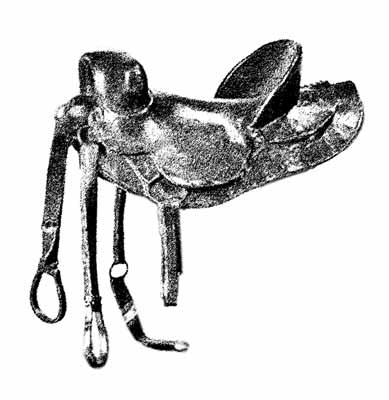
The Inaugural Ride
Bascom took his newly-made hornless saddle to the 1922 Cardston (Alberta, Canada) Stampede for its inaugural bronc ride.
At Cardston, the saddle caused quite a sensation with the bronc riders and with the press.
They called the saddle, the "mulee," the cowboy term for a cow without horns.
Bascom's saddle became very popular among the cowboys, especially after Art Lund, a cowboy from Skiff, Alberta, used it to win the Cardston Stampede Saddle Bronc Riding Championship.
But he won it by good luck.
Art Lund drew one of the toughest broncs of the rodeo, one owned by the Knight and Day Stampede company.
Art found that the bronc was just about too much for him to handle.
He was showing too much "daylight" and grabbed for the saddle horn to "pull leather" to keep himself from being thrown out of the saddle.
Pulling leather would disqualify his ride, but it would save him from going airborne and having a hard landing on the ground.
Fortunately, the saddle horn was not there, so Art went on to finish the ride - winning the championship.
The next year of 1923 at the Cardston Stampede, Bascom rode his hornless saddle with a high-point ride that placed him in the top four riders in the saddle bronc riding finals.
At the Cardston Stampede Championship Finals, Bascom was competing against some of Canada's greatest bronc riders, one of which was the 1912 World Champion Bronc Rider, Tom Three Persons.
Earl made a good ride, especially since he was only sixteen years old, but Tom Three Persons was crowned the winner.
From then on, the idea of a hornless rodeo saddle caught on.
Cowboys began sawing off the horn or hammering it down until the cap of the horn touched the front of the fork of the saddle.
Bascom's Saddle and The Severe Brothers
In 1958, two saddle makers in Pendleton, Oregon, originally from Idaho, Duffin "Duff" Severe and his younger brother Billy Severe, were the first to start commercially producing hornless bronc saddles for the general rodeo market, following Bascom's original idea.
The Severe brothers had apprenticed as saddle makers at the well-known saddle company, Hamley and Company, before starting their own Severe Brothers Saddlery in 1955.
Having made scores of hornless bronc saddles over the years, these Severe saddles were considered the "Cadillacs" of the highest quality and workmanship.
- Duff Severe was the first saddle maker to be recognized as a Master Traditional Artist by the Smithsonian Institute.
- Duff and his saddle work were featured in the National Geographic Magazine.
- He was honored by the National Endowment for the Arts in Washington, D.C. as a National Heritage Fellow.
- He was hailed as the "greatest western saddle maker in the country" having made a western saddle for a President of the United States - President Gerald Ford.
These renowned saddle makers, the Severe brothers, were distant cousins to Earl Bascom.
Bascom's Saddle Goes Abroad
Another Bascom relative, Lyman Tenney, is known as the first to promote and produce the hornless bronc saddle internationally, in Australia.
Born and raised a cowboy in Arizona, Lyman and his wife Alaire along with their son Todd, spent some 17 years in Australia, managing a million-acre ranch and giving rodeo clinics at venues across Australia and Tasmania.
Their rodeo clinics taught bronc riding and bull riding, as well as team roping.
Lyman has been called the "Father of Australian Team Roping," having introduced that rodeo event to the Land Down Under.
In 1971, with two business partners, Lyman formed the CTG Company producing the first Australian-made American-style rodeo saddle trees.
These trees were then sold to Australian saddle makers who finished them into hornless rodeo bronc saddles.
Earl Bascom's Saddle Today
Today, the hornless bronc saddle, first created by Earl Bascom over 100 years ago in 1922, is the rodeo standard around the world, used at rodeos and by rodeo associations across Canada, the United States, New Zealand, Australia, Tasmania, South Africa and Europe.
A variety of saddle makers now make the modern bronc saddle.
About Earl Bascom
Earl Bascom has been called rodeo's greatest equipment designer and maker, with innovations that include the bronc saddle, the modern bucking chute, modern bareback rigging and the modern rodeo chaps.
Retiring from rodeo in 1940 and graduating from Brigham Young University with a degree in Fine Art, Bascom became an acclaimed cowboy artist and sculptor, being the first and only cowboy to be made a Fellow of the Royal Society of Arts of London.
Bascom has also been inducted into several halls of fame, including the Rodeo Hall of Fame in Oklahoma City, the Utah Rodeo Hall of Fame, the Canadian ProRodeo Hall of Fame, and given the PRCA Hall of Fame "Pioneer Award."
He was the first rodeo champion to be made a Peer of Canada's Order of Sports - Canada's highest and most prestigious sports award.
Bascom's rodeo innovation of 1922, the hornless bronc saddle, is now honored in a permanent display at the Canadian ProRodeo Hall of Fame in Ponoka, Alberta.
Below: Earl Bascom's bronze of his 1922 rodeo saddle.
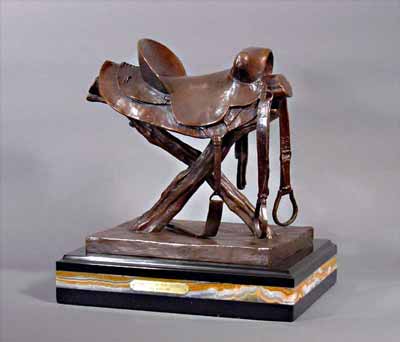
You might also like:
- What Is The History Of The Modern Rodeo Bucking Chute?
- What Is The History Of The One-Hand Bareback Rigging?
Below: Earl W. Bascom, "The Father Of Modern Rodeo."
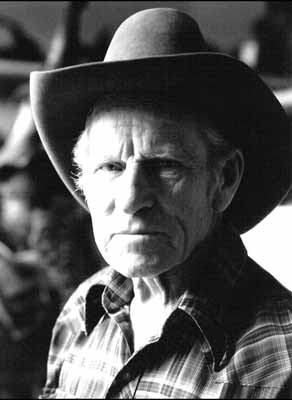
This article was contributed by guest author John Bascom and is being used with permission.
About The Author
Guest author John Bascom is the son of Earl W. Bascom. We thank him for sharing this article about his father.
For more information about Earl W. Bascom:
What Is / Are...
… What Are 5 Of The Biggest Wild West Robberies?
… What Are 5 Reasons Horse Trailer Lighting Matters?
… What Are 8 Dumb Things To Say To A Horse Lover?
… What Are 9 Proven Ways To Keep Flies Off Horses?
… What Are Chestnuts and Ergots?
… What Are The Parts Of A Western Saddle?
… What Are Saddle Rigging Positions?
… What Are Some Fencing Options?
… What Are Some Foods Both Horses And Dogs Can Eat?
… What Are Some Horse Fencing Basics?
… What Are Some Interesting Horse Facts?
… What Are Some Interesting Charts and Graphs With Horse Information?
… What Are Some Options For Temporary Horse Fencing?
… What Are Synthetic Saddles Made Of?
… What Are The Rodeo Catch Pens?
… What Are The 10 Best 3-Horse Trailers With Living Quarters In The USA And Canada?
… What Are The X's In A Cowboy Hat?
… What Are The Three Legal Head Catches?
… What Is The Angle System For Branding?
… What Is The Barrel Racing Pattern?
… What Is A Bull Riding Vest Made Of?
… What Is Deworming Your Horse?
… What Is A Domain Name?
Why would I need one for my farm or ranch even if I don't have or
want a website?
… What Is A Fifth Wheel Trailer Hitch?
… What Is Flag and National Anthem Etiquette At A Rodeo?
… What Is A Slant Load Horse Trailer?
… What Is Floating A Horse's Teeth?
… What Do Horse Freeze Brands Look Like?
… What Is A Galvayne's Groove?
… What Is A Gooseneck Trailer Hitch?
… What Is Some History About The First National Finals Rodeo?
… What Is The History Of The Modern, Hornless, Bronc Riding Saddle?
… What Is The History Of The Modern Rodeo Bucking Chute?
… What Is The History Of The One-Hand Bareback Rigging?
… What Is The Nasolacrimal Duct In Horses?
… What Is A Pony Express Mochila?
… What Is Hermann Oak Leather?
… What Is Larvicidal De-Worming?
… What Is The Flehmen Response?
… What Is The Rodeo Return Gate?
… What Is A Safety Tip For Posting The Colors?
… What Is A Slick Fork Saddle?
… What Is A Swell Fork Saddle?
You Might Also Like
